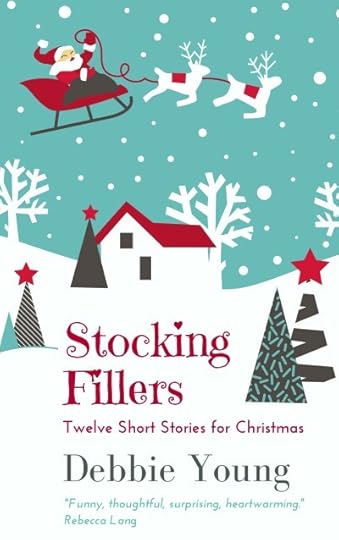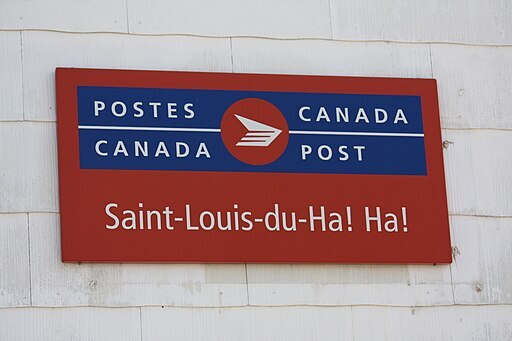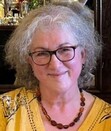Debbie Young's Blog, page 7
January 31, 2024
A Tribute to Clare Weiner aka Mari Howard
A post celebrating the late author, poet and artist Clare Weiner, who wrote as Mari Howard
Last autumn, when I was planning my priorities for 2024, I decided that I’d post on my blog every Wednesday, and that the last Wednesday of each month would be a guest post by or about author friend. I never imagined that the first of these posts would be a tribute to author, poet and artist Clare Weiner, who published her books under the pen-name Mari Howard, following her untimely death from a sudden heart attack on 7th December 2023. The following post is an amalgam of tributes by our mutual friends within the writing community.
I first met Clare about 10 years ago when I was manning an exhibition stand at a writers’ event in London for the Alliance of Independent Authors (ALLi) (affiliate link). Clare approached me and introduced herself, buttonholing me for some time as she described her work and also questioned me at length about how joining ALLi might help her achieve her writing ambitions. I was immediately struck by her intelligence and tenacity, and how thoroughly and deeply she thought things through.
She joined ALLi, and in the years that followed we became good friends, although the distance between our homes meant that we met in real life only occasionally. My first impressions held true, as I discovered when I read her debut novel, Baby Baby; her second, The Labyrinth Year; and then last autumn her third, Farewell Fifteen, which completed her planned trilogy, The Mullins Family Saga. In these contemporary family saga novels, she explored complex ethical issues where science meets faith with thoughtfulness and balance.
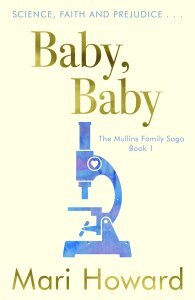 The first in the Mullins Family Saga trilogy
The first in the Mullins Family Saga trilogy
A determined independent publisher of her own books, she enjoyed networking with other indie authors and conversing about a wide range of issues with fellow ALLis.
ALLi’s founder, Orna Ross, says, “Clare always impressed me with her determination. I know the technicalities of self-publishing were not her natural bent, but she didn’t let that (or anything) stop her. It’s a shame she didn’t have longer to make her contribution, and I am so pleased to know her legacy will live on through her books.”
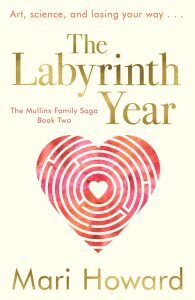 The second in the Mulins Family Saga
The second in the Mulins Family SagaClare’s considered contributions to group discussion on the ALLi membership forum were always appreciated.
“Clare was a valued member who contributed to our group,” says Helen Baggott, editor and author.
“Clare was always so supportive and active in this group,” says Clare Flynn, historical novelist.
As well as her intellect and integrity, her warmth stood out. “She was lovely,” says crimewriter Wendy H Jones. “Clare was a lovely lady and wonderful writer,” says children’s author Hilary Hawkes.
Her generosity to her author friends was much appreciated. “A fine writer herself, she was also very supportive of other writers,” says Dr Carol Cooper, novelist and author of medical non-fiction.
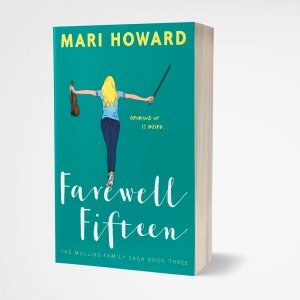 Clare was planning to rebrand the first two in the trilogy to match the design for book three
Clare was planning to rebrand the first two in the trilogy to match the design for book threeNovelist Lynne Pardoe has fond memories of pre-pandemic real-life meetings with Clare in Oxford, when we co-ran an indie authors’ group. “I so much enjoyed knowing her, and it’s not that often you meet someone who shares the same faith and political news Clare and I did,” says Lynne. Along with other Oxfordshire authors such as Dan Holloway and Thomas Shepherd, we enjoyed some stimulating meetings in Oxford, including a memorable talk about lexicography by her husband Edmund, Deputy Editor of the Oxford English Dictionary.
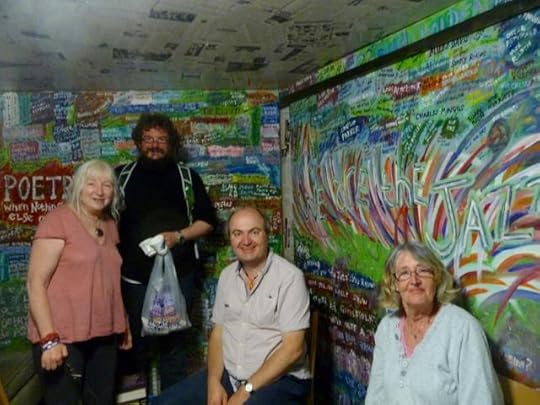 Having bookish fun with author friends Lynne Pardoe, Dan Holloway and Thomas Shepherd at the Albion Beatnik Bookshop, Oxford
Having bookish fun with author friends Lynne Pardoe, Dan Holloway and Thomas Shepherd at the Albion Beatnik Bookshop, OxfordAnother author friend, Griselda Hamway, who had known Clare and her family for many years through church, paid a touching tribute to Clare on her latest post on the Authors Electric blog, a collaborative site on which Griselda and Clare (and a few years ago, I too) each contributed a monthly post.
Read Clare’s last post on Authors Electric, an upbeat post celebrating the institution of the Art Shop, here:
https://authorselectric.blogspot.com/2023/11/the-art-shop.html
Read Griselda’s tribute here:
https://authorselectric.blogspot.com/2023/12/celebrating-human-spirit-sadness-and.html
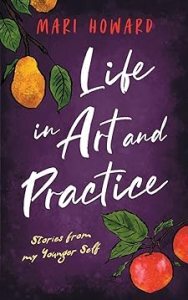 Clare’s collection of short stories
Clare’s collection of short storiesAlthough Howard Lovy, an author, editor and journalist based in Michigan USA, never met Clare in real life, he says, “I had the honor of interviewing Clare a few years ago for ALLi’s Inspirational Indie Authors podcast”. Howard kindly sent this link to their podcast as his tribute:
http://www.selfpublishingadvice.org/science-and-religion/
Clare was much more than an author and poet. She was also a gifted artist (view her gallery of paintings here) and photographer, sharing beautiful wildlife pictures all year round. “I loved her nature posts on Facebook too,” says author Ali Bacon.
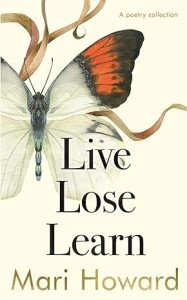 Clare’s collection of poems compiled to bring to the Hawkesbury Upton Literature Festival
Clare’s collection of poems compiled to bring to the Hawkesbury Upton Literature FestivalBut it was for her writing that I invited her to take part in the very first Hawkesbury Upton Literature Festival back in 2015, and she and her husband Edmund were great supporters of the programme long-term. Clare was a member of various discussion panels over the years and also gave readings from her novels and from her poetry. Here she is sharing a reading from her work at the inaugural HULF.
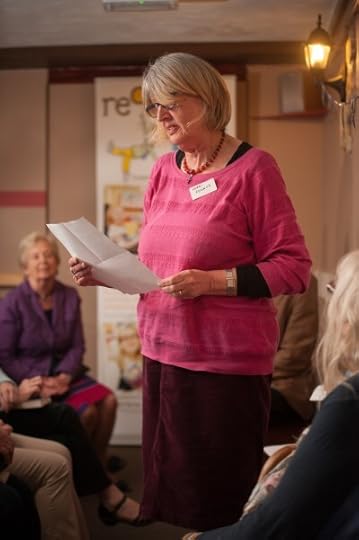 Picture by Clint Randall http://www.pixelprphotography.co.uk
Picture by Clint Randall http://www.pixelprphotography.co.ukBecause I believed in Clare’s talent, I was always pleased to help her, and I was especially glad to be able to introduce her to book designer and illustrator Rachel Lawston, who had done such a brilliant job designing my self-published book covers. They soon formed a close collaboration on new covers and branding for Clare’s work.
Rachel has given me permission to share her own highly entertaining tribute to Clare here:
Rachel Lawston’s Tribute to ClareMy most cherished memories of Clare will always be our “quick five-minute chats” that would turn into hours-long conversations.
Our calls were like a lavish twelve-course meal at a Michelin-starred restaurant. Here’s how they usually went:
Course One – Hors D’Oeuvres: We would start with a quick chat about what we had been doing before the call (around fifteen minutes).Course Two – Amuse-Bouche: Moriarty (Rachel’s cat) rudely interrupts us. We would take a moment to appreciate cats.Course Three – Soup: Our cat updates would quickly turn into stories about nature sightings.Course Four – Appetizer: From there, we would talk about our trips to local nature reserves and share stories about our latest holidays.Course Five – Salad: Clare would update me on her grandchildren and her family.Course Six – Fish: Husband chat. By this point, we would lose track of time and have no idea how long the call had been going on.Course Seven – Paul (Rachel’s husband) would arrive home and say a quick hello. We would chat about what he and Edmund (Clare’s husband) were cooking for dinner.Course Eight – Palate Cleanser: Clare asks Paul about the WWT London Wetland Centre, Paul makes a swift exit to the kitchen and our discussion quickly turns to politics.Course Nine – Second Main Course: We would both express our dislike for Boris.Course Ten – Cheese Course: We would both express our disdain for the Tories.Course Eleven – Dessert: Our discussion naturally unfolds into the history of the UK and our predictions for the next year.Course Twelve – Mignardise: We would end our call with Clare sharing what she would do if she were the Prime Minister of the UK.Taxi home – we are both summoned by our husbands to the dinner table.
HULF’s Tribute to ClareI know how much Clare loved coming to the Hawkesbury Upton Literature Festival, and how disappointed she was when the pandemic or her own ill health prevented her attendance. The next HULF event is set for Saturday 27th April, and I would like to dedicate this event to Clare’s memory. It will be held in our beautiful, tranquil parish church of St Mary the Virgin, where I know she and Edmund enjoyed spending time on one of their visits to Hawkesbury.
The theme for the Spring 2024 HULF is “A Sense of Place” – something that Clare evoked so well in her writing, her photography and her art. (There’s a gallery of her photos of the settings in her books here.) Edmund has kindly given his permission for us to read an appropriate extract from her work, and he hopes to be present to read it himself.
Book HULF tickets via Eventbrite here:
https://www.eventbrite.co.uk/e/hawkesbury-upton-literature-festival-spring-event-a-sense-of-place-tickets-800093781037
If you would like to buy, read and review Clare’s books, her novels are available to order as ebooks and in paperback from Amazon.
All her books will also soon be available to order direct from her website here: https://www.marihowardauthorandpainter.co.uk/
Thank you, Clare, for all you have been to all of us. Our heartfelt condolences to Edmund and to all your family and friends.
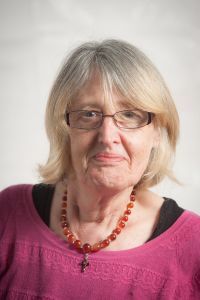 Clare Weiner , 1946-2024
Clare Weiner , 1946-2024
January 24, 2024
From Manuscript to Published Book: My Writing Process
A post about my writing process, from handwritten manuscript to printed book
When I posted this photo on my Facebook author page the other day, wondering whether or not to keep the notebooks containing the first draft of my latest novel, Driven to Murder, which will be published on Friday 26th January, I was blown away by readers’ interest and enthusiasm in my writing process. Inspired by a question from my friend Carol Jennings, I thought I’d use this week’s blog post to explain just how I write a novel.
PLANNING A BOOKBefore I start writing a book, I plan the plot. A surprising number of authors start writing without knowing what’s going to happen next. Lee Child is a famous example of this approach, which is known in the trade as being a pantser (as in “fly by the seat of your pants”) or, more poetically, a discovery writer. That’s not for me: I like to have a basic plan, not least because I write mysteries, and I want to know from the start who my criminals are.
Agatha Christie didn’t work that way: legend has it that she used to get part way through writing a novel, send the partial manuscript to friends inviting them to guess who the murderer would be, and then she’d pick the one that fewest of them guessed.
My plan starts out as a single sentence per chapter, always by hand, and often on notecards, which make it easier to change the order of events as the story comes together.
Then I type it up, and at that stage I start adding in a few details as they occur to me – character names, details of setting, timing, and more.
I print it out in large print so that it’s easy to see at a glance, and leave lots of white space on the page so that I can scribble more notes on it as I go along, fleshing it out into a more substantial outline.
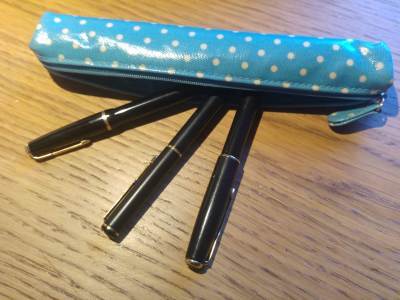
Then I grab a fresh new notebook – soft-backed Moleskine, from choice – and start writing by hand, working my way sequentially through the plan without stopping.
Some writers don’t write their books in the same order as their finished story, but write the start and finish first, then fill in the bits in between. A popular remedy for anyone who thinks they have writer’s block (which I don’t believe in, but I’ll save that conversation for another post) to skip any sections they’re struggling with, and to come back to write those later.
I always write my first drafts by hand – there’s a previous post here if you’d like to know more about that – but essentially it’s because I write fiction more fluently and naturally than when I’m typing, even though I’m a very fast touch-typist.
There is plenty of scientific evidence demonstrating that handwriting taps in more effectively to the creative part of your brain than typing does.
Before I start a fresh writing session, I usually reread the last chapter I’ve written, to remind me where I left off. I don’t write every day – there’s too much else going on in my life – but when I’m working on a new novel, I write at least a chapter a day. I scribble a few edits on it as I’m reading, but the bulk of the editing starts when I’m typing it up.
When my daughter’s home from university, she kindly types my manuscripts for me to speed up the process, in return for fair payment, of course!

Then I print out the typescript and edit the fresh paper copy by hand, before typing in the edits on my computer.
Rinse and repeat, as the saying goes… I usually go through this process quite a few times, until I can’t think of any more improvements. Then it’s ready to go to my publisher for structural edits.
 Not from the school in my Gemma Lamb novels – but a souvenir from my visit to St Bride’s Church, Fleet Street, LondonTHE PUBLISHER’S EDITING PROCESS
Not from the school in my Gemma Lamb novels – but a souvenir from my visit to St Bride’s Church, Fleet Street, LondonTHE PUBLISHER’S EDITING PROCESSThe structural editor sends me back notes – eg this chapter isn’t necessary; this bit needs more details; you’ve jumped from Wednesday to Friday with no Thursday in between; hang on, Susan just entered the room twice without leaving it in between.
I make changes to reflect her suggestions, send her back the revised copy, which she checks, before forwarding it to a copy editor, who checks the language, sense and continuity, before returning to me yet another set of recommendations.
After I’ve processed the copy editor’s feedback, the manuscript goes to the proofreader. Technically the proofreader is just looking for typos and layout errors, but if she spots anything the others have missed, she’ll flag those up too.
So then it’s a last round of checking for me, reading every word now to make sure no further errors have cropped up in the meantime. By this time I can practically recite the whole book and can’t wait to get it off my desk.
I send this final copy to my publisher, who sends it to production for “cleaning“, ie removing all the comments and conversations that the editing team have marked up on the manuscript, and formatting it in their house style ready for publication.
And we’re done! Hurrah!
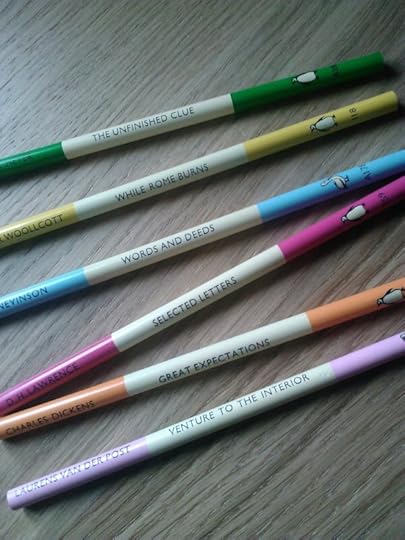 The more colours for editing on paper, the betterTO PRINT AT LAST (AND EBOOK AND AUDIO…)
The more colours for editing on paper, the betterTO PRINT AT LAST (AND EBOOK AND AUDIO…)In the meantime, I start planning my next book, and am usually so immersed in the new story that by the time the edited book is ready for launch, I’ve almost forgotten about it.
Then comes a flurry of preparation for its release, including writing blog posts and other launch material for my publisher.
I also dream up PR ideas for my own blog and social media – such as taking the picture of the manuscript notebooks and my first printed copy, which I shared on Facebook and Instagram earlier this week.
Which is where I came in…
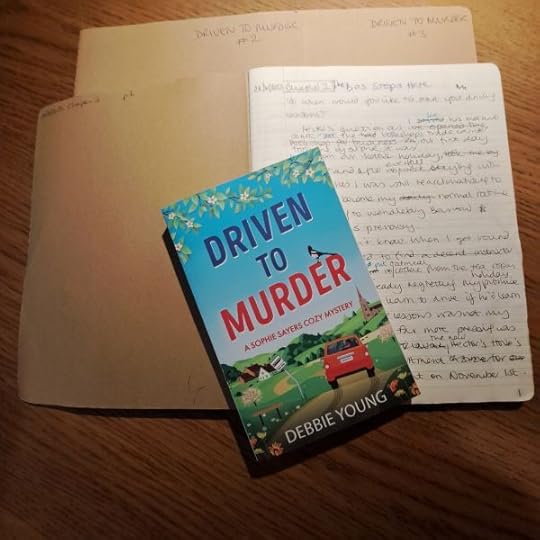
Driven to Murder will be launched this coming Friday, 26th January, on all the usual retail platforms, in ebook, paperback, audio, hardback and large print. The paperback and ebook are already available to preorder here.
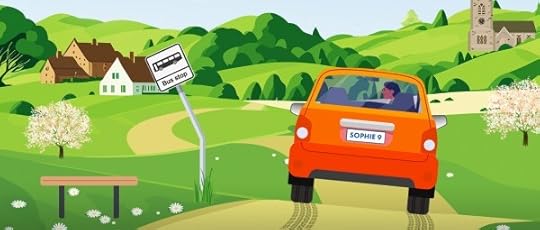
Climb aboard for an entertaining journey with Sophie Sayers as she seeks to solve the mystery of a murder on the village bus and to save the vital bus service from being axed – preferably without any more murders along the way!
January 17, 2024
Driving Lesson Disasters with Sophie Sayers and Friends
In the run-up to next week’s launch of my ninth Sophie Sayers Cozy Mystery, Driven to Murder, in which Sophie learns to drive, I asked author friends at my publisher Boldwood Books whether they had any funny stories or cautionary tales about their own driving lessons and tests.
Their flood of answers made me wonder whether anyone ever learns to drive without mishap! Huge thanks to Team Boldwood for allowing me share their entertaining anecdotes on my blog today, interspersed with some exclusive excerpts from Driven to Murder.
As Sophie discovers, beginner’s nerves can be a challenge. Says Donovan Cook , “I did my driving test in the winter and had to do a reverse around the corner, which I hated and was terrible at. Naturally, I messed it up and because I knew I messed it up, I became that nervous that I fogged the car up and we had to wait a while for the car to de-fog before we could carry on with the test, which I failed .”
When Friends Can be FoesOne might feel less nervous if taught by a friend, but Sophie fears damaging her relationship if she lets Hector teach her. Here she’s trying to break to him gently that he’s not her first choice of instructor.
‘Before I can go any further, I need to find a decent driving instructor. I’d thought about giving the local guy a ring. I’ve seen his red hatchback about the village, with the sign on top – “Succeed with Saxon”. I expect he’s booked up ages in advance though, so no rush.’
Hector turned his doleful lost puppy look on me, green eyes wide beneath his dark curls. ‘Why pay good money to a driving instructor when I can teach you? I thought it might be fun to give you your first lesson after work tonight. Look, I’ve just made you a present.’
From beneath the trade counter, he produced a pair of white cardboard squares, each bearing a large red letter ‘L’ for ‘Learner’. He must have printed them on the shop’s laser printer.
‘You’ve laminated them,’ I faltered. ‘Are you sure home-made L-plates are legal?’
Any excuse would do to postpone the ordeal. Still at the honeymoon stage of our relationship, Hector and I hardly ever argued. I didn’t want driving lessons to upset our comfortable status quo.
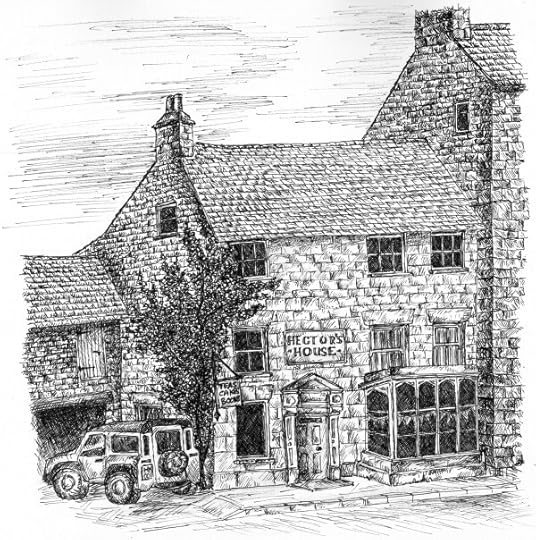 Sophie’s first driving lesson is in Hector’s beloved Land Rover – pictured here outside his Hector’s House bookshop in T E Shepherd’s lovely illustration (Copyright Thomas Shepherd http://www.teshepherd.art.com)
Sophie’s first driving lesson is in Hector’s beloved Land Rover – pictured here outside his Hector’s House bookshop in T E Shepherd’s lovely illustration (Copyright Thomas Shepherd http://www.teshepherd.art.com)M J Porter learned the hard way to avoid lessons with her father: “I had the slowest crash while under my Dad’s driving instruction. It was the first time driving the family car, and he told me to brake, which I did, but the brake pedal wasn’t as responsive as the one in the instructor’s car, and I slowly, slowly, slowly, crashed into one of the signs on a roundabout which tell you which way to go. Nightmare. I never went out with him again.”
The Perils of Professional Driving InstructorsBut as Sophie discovers, hiring a professional instructor can bring its own problems. Here she is on her first lesson with local teacher Saxon Arch:
His right hand bypassed the gear stick and landed on my left thigh. ‘There are other ways of paying, if you get my drift.’
Instinctively, I let go of the steering wheel to slap his straying hand. ‘How dare you!’
He recoiled as if at an explosion.
‘You bring me out here and insult my boyfriend, besmirch the memory of my lovely great aunt, and then lay your grubby hands on me! That’s nothing short of assault.’
I steered the car towards the car park’s exit sign.
‘I’ve had enough of this. I’m driving us straight home now.’ I swung the car onto the lane, taking only a small piece of hedgerow with us. As we headed through the winding lanes in second gear, I ignored Saxon’s sharp intakes of breath. I wasn’t entirely confident about changing gears yet and thought it better to stick with the gear I knew best.
‘If you think you’re getting any more business from me, you’ve got another think coming,’ I stormed, steering abruptly into a layby to let a tractor pass. ‘And I’m not paying for this lesson either, as I’ll have had barely twenty minutes behind the wheel by the time I get home.’
Saxon, wide-eyed, was gripping the dashboard with both hands now. At least that meant he was keeping them away from me.
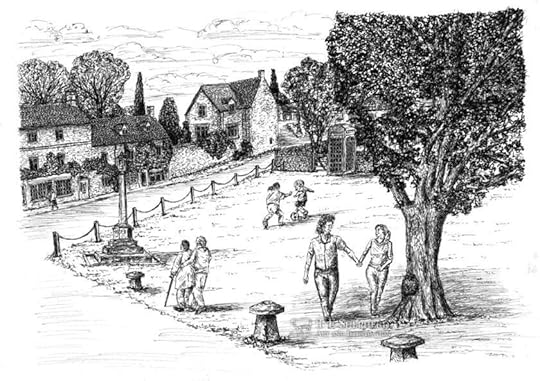 Fortunately the lanes are around Sophie’s village of Wendlebury Barrow are usually quiet. Unfortunately they’re mostly single-track – not easy for novices to navigate. (Image © T E Shepherd http://www.teshepherdart.com)
Fortunately the lanes are around Sophie’s village of Wendlebury Barrow are usually quiet. Unfortunately they’re mostly single-track – not easy for novices to navigate. (Image © T E Shepherd http://www.teshepherdart.com)Like Sophie, Jessica Redland picked the wrong instructor. “For my very first driving lesson on my 17th birthday, the instructor drove me to a remote, empty car park 15 minutes from home below a hill. He spent ages drawing a picture of a gear box and explaining how it works (yawn!) We had enough time for me to attempt to drive up and down the car park twice, using first, second and reverse gears before having to drive home, an hour’s lesson gone. What a swizz! Looking back later, it struck me how wrong it was for him to take me somewhere so remote. I lasted my six booked lessons with him and ditched him. I found him very creepy!”
Fenella Miller had problems with her first instructor too. “On my first lesson, the instructor made me hold a washing up bowl and pretend I was driving. He ended up sectioned a week later.” Not the obvious way to get to grips with the technology of cars – another problem that Sophie encounters. Here she is trying to master which pedal does what on Hector’s Land Rover in the middle of a disused airfield. Hector is trying to keep it simple:
‘Just remember, the pedals are in alphabetical order by function. A,B,C: accelerator, brake, clutch.’
‘Copy that!’ I replied brightly, the airfield setting going to my head. Now I imagined taking flight, like Chitty Chitty Bang Bang. Once I’d mastered driving, perhaps I could learn to fly a plane.
I tapped each pedal, from left to right, with the tip of my right shoe. ‘Accelerator, brake, clutch.’
Hector facepalmed. ‘No, no, Sophie, other way round. Like I said, A, B, C.’
When he pointed at the pedals again, I realised he was going from right to left. I thumped the steering wheel.
‘Oh, for goodness’ sake, make your mind up! That’s reverse alphabetical order. In this country, we read from left to right. It’s C, B, A.’
‘That’s why I pointed, so you could see which pedal was which.’ He wagged his finger in the air. ‘You know what I mean. Same difference.’
I scowled. ‘It’s not the same thing at all. You’d soon complain if I sorted our fiction section in reverse alphabetical order.’
 Although often tricky to navigate, the winding, narrow Cotswold rural lanes are very scenicTesting Times with Tricky Examiners
Although often tricky to navigate, the winding, narrow Cotswold rural lanes are very scenicTesting Times with Tricky ExaminersOf course, we can pick our driving instructors, but not our examiners. Leonie Mack had an unfortunate experience on her driving test: “The guy who invigilated my driving test was a real weirdo. I was studying journalism at uni and when he found that out he started ranting about how awful and immoral journalists are and how they invade privacy and I think he told me a personal story about how a journalist hounded him for something and I was a clueless first-year just trying to pass my test!”
Fortunately, Sophie is luckier with her examiner, although not everything goes smoothly. But at least she is luckier than Maddie Please, who told me, “I failed my first driving test when I pulled out of the test centre and stalled in the middle of the road. The examiner rolled his eyes at me and said, ‘Well let’s just have a nice drive shall we?'” I suppose it could have been a lot worse – at least he was kind about it!
Feel the Fear and Fail Anyway…Plenty more of my author friends failed their driving tests at least once. When I passed second time, my instructor told me I’d be a better driver for my earlier failure, because it would make me a more careful driver. It irked me at the time, as I’d never failed any other kind of exam before, but – eventually – I was thankful for the experience.
Rachel Burton and her family also had the “benefit” of failing first time. “I failed one test for speeding and one for driving out of the “entry only” gate at the driving centre,” she confesses. “My husband failed for driving on the wrong side of the road. My mum had the best one though. She drove out of the driving centre on her first test and straight into the back of a bus.”
Edie Baylis has a string of driving test horror stories to share. “On my test I slightly scuffed the kerb on the reverse round the corner manoeuvre and in classic 17-year-old fashion, I yanked on the handbrake, yelled “I’ve screwed that up now!” and proceeded to get out of the car and walk off having a meltdown, leaving the examiner sitting there. Afterwards, I discovered that he hadn’t noticed the scuff (it was barely a touch but I’m a perfectionist) and was about to pass me…. But I walked off… Doh! Needless to say in my retest I didn’t have a meltdown, but it was close when on the same manoeuvre, I’d just got round the corner perfectly and almost finished when a car indicated to turn into the road, and I had stop and go back out the road and wait to do it again once the usurping car had gone. I was even more furious when I realised the driver of that other car was only my bloody mother! My ex passed his test by writing the test car off four minutes into the test. He passed because he’d dealt with the accident/exchanging details correctly!”
Jo Lovett has another set of disaster stories. “My daughter failed her third driving test for speeding. A couple of weeks before that she was having a lesson and accidentally doing 50 in a 30 zone, and her instructor lost it and yelled, “Jesus Christ, woman, you’re going to kill us.” A friend taught me before my second test and he wouldn’t let me drive under 35mph for petrol consumption reasons. I drove too fast right at the beginning of my test and was only saved from running a woman with a buggy over on a zebra crossing by the examiner slamming his brakes on. Then we had to carry on and do the whole thing. In those days they ticked boxes of things you’d failed on and he ticked every single box except two. I’m an ok driver now!”
In contrast, Sarah Bennett taught her examiner a new trick. “I lived in Swindon when I learnt to drive and everyone who lived there had to make it across the Magic Roundabout unscathed (if you haven’t ever seen it there is one central roundabout in the middle surrounded by five other mini roundabouts). When I was taking my test, we approached it from direction I had never come from before and when I set off, the invigilator said “oh, we’ll go this way”. I had a proper panic and started asking if I’d done it wrong, had I failed etc and he said “just keep going”. Thankfully we were almost finished but I was convinced that I must have failed. When we stopped at the centre he apologised immediately for being unprofessional and that he should not have said anything but I had taken him by surprise. He told me that he used that route every day and it had never occurred to him to follow the route I had chosen and that it was actually more efficient than his usual route and he would be using it from then on! I passed but I’m not sure if that’s because I was good enough or if he was embarrassed or delighted I’d made his daily commute easier.”
Ruby Speechley also struck lucky. “I stalled on a hill during my driving test. I thought oh well, I’ve failed so relaxed and carried on. I was amazed when he said I’d passed and asked him if he felt sorry for me because I was pregnant. He said no, he didn’t even know I was pregnant! (I was so skinny and 6 months pregnant with my first child and had the tiniest bump).”
Sarah Hope also found hills a hazard. “My childhood home was on a hill, and almost every time I pulled up outside the front of it, my instructor’s car would start rolling down the hill despite the handbrake being pulled up. Of course, this was always my fault – I should have pulled the handbrake up more – rather than his dodgy car!”
When Sophie takes her test, she doesn’t let the unreasonable demands of the driving examiner get her down:
My confidence faded once I was sitting beside the examiner, a stern, elderly chap with the severe hairline of a monk’s tonsure. I tried not to think about my recent discovery that monks wore their hair in that style not for religious reasons, but to reduce nit infestation. Whatever happened, I shouldn’t take my hands off the wheel to scratch my head.
‘Get a move on!’ he cried, at one point, as I took my time pulling out to overtake a milk float. That seemed needlessly cruel. I wasn’t going to let this guy push me around, just because he had a licence, and I didn’t.
‘I’m sorry, but I’m not going to overtake unless I can see the amount of road clear that I need to complete the manoeuvre,’ I said. ‘And I can see the road ahead better than you can from the passenger seat.’
‘When I hit the dashboard with my pen, you’re to do an emergency stop,’ he announced a few minutes later as we reached a clear, straight stretch of road.
I glanced in my rear-view mirror. ‘Well, don’t do it just yet, or that idiot who is far too close to my back bumper will go piling straight into me.’
His pen was already in mid-air when he glanced at the wing mirror on his side of the car.
‘Next left,’ he barked.
Our follower carried on down the main road. In the side street we’d turned into, there were no moving vehicles in front or behind us, only parked cars on either side.
‘Okay,’ he murmured, and tapped the dashboard.
I slammed my feet so hard on the clutch and brake that he lurched forward and fell back hard against his seat.
‘Full marks for reaction time,’ he conceded, rubbing the back of his head where it had collided with the head restraint. Just as well the head restraint was there, or his head might have ricocheted off the parcel shelf.
Finally, he commanded me to pull into the test centre car park and pointed to an empty space. Although I could more easily have driven straight into it, I showed off by reversing neatly in. I wanted to make him feel bad for having failed me.
Not all driving lesson disasters are the fault of the learner.
J A Baker recalls: “My instructor got into a road rage argument with another driver while I was heading down a busy road in rush hour traffic. It was so bad that he undid his seatbelt and clambered into the backseat to give the other driver behind us the finger.”
Poor Jennifer Bohnet could hardly have been expected to anticipate the obstruction she describes here. “When I took my test many years ago in Bristol, the large zoo there was still operational, and about halfway through the test the examiner told me to take the next right, followed by a left. The right turn was quickly followed by an unscheduled emergency stop – two elephants out for their daily constitutional were coming towards us.”
You wouldn’t find elephants on the highway these days – nor would you be allowed to drive unaccompanied on a provisional licence, as Valerie Keogh did back in the day in her native Ireland: “When I got my first car, a mini, I decided to drive to show it off to my sister – it was okay going, but on the return journey I needed to turn left off the dual-carriage way – I was so worried about getting into the correct lane that I drove about 5 miles in the right-hand lane at about 20 mph. On a Sunday afternoon.”
Last Word from a Former Driving InstructorTo be fair, let’s finish with some funny stories from the driving professional’s perspective. Former driving instructor Phoebe MacLeod shares just a few favourite anecdotes. “I have an arsenal of stories, from the “mature” lady I taught who farted every time something surprised her (I knew she’d failed her second test the moment I opened the car door), to the clueless 17-year-old posh boy with no road sense who used (literally) to stab at every pedal with any foot until he found the one he wanted. His mother was equally scary, reprimanding me because he wasn’t stopping at every roundabout. After careful explanation that he’d likely end up with another car in his boot if he did that, and some tactful but honest appraisal of his driving skills, he was packed off to somewhere remote for his test. There’s plenty more where that came from… ”
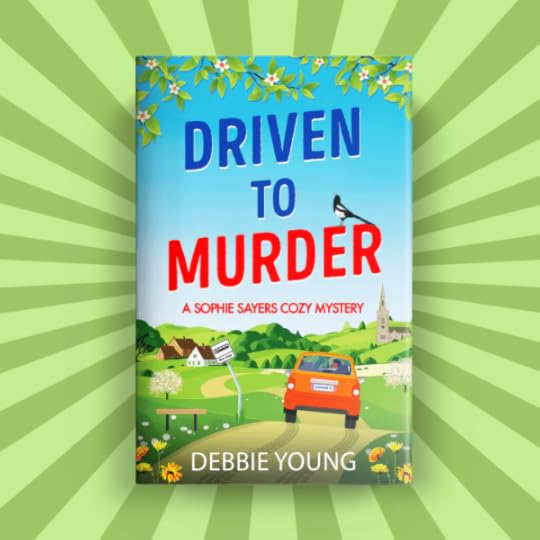 Launching 26th January 2024
Launching 26th January 2024To read more about Sophie Sayers’ adventures on the road – including her quest to solve a bus passenger’s murder and to save the local bus service – pre-order Driven to Murder from your favourite bookstore now! It’ll be launched by Boldwood Books on Friday 26th January in ebook, paperback and audio, and hardback will follow soon.
Click here to order your copy now – or ask for it by name at your local bookstore.
January 10, 2024
How to Choose Which Books to Read
A post about my reading habits with top tips to make your own reading more fun this year
At the turn of the year, many people set themselves a reading goal in terms of quantity, eg “I will read 52 books in 2024”.
This always strikes me as an odd approach, because surely the joy of reading doesn’t increase according to quantity?
It’s not like pledging to lose x pounds in weight: a pound of flesh = a pound of flesh, (although a pound of muscle is very different from a pound of fat).
This numeric approach can distract people from thinking about how much they’ve enjoyed the books.
It risks turning reading into a box-ticking exercise rather than the adventure that it should be.
It also encourages readers who are running out of time to reach their goal to pick shorter books towards the end of the year, even when they might rather be getting stuck into a more substantial tome.
How I Keep Track of What I’ve ReadI do keep track of the books I’ve read, but only by keeping a list (unnumbered) in a little notebook, inspired by my mum, who has been doing this for years. I like being able to look back and remind myself what I’ve read, especially if I’ve forgotten a title and want to recommend it to a friend or to read more by the same author. The only other detail I include is the month in which I’ve read it.
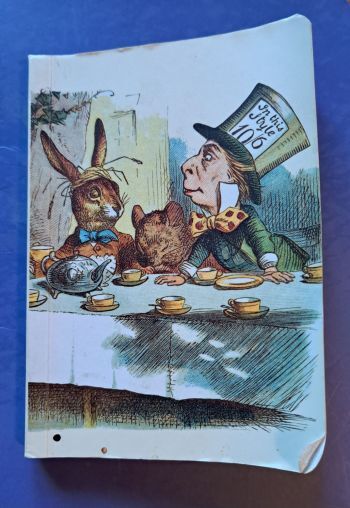 My reading log-book is getting a little dog-eared after four years of use
My reading log-book is getting a little dog-eared after four years of useSome months I read more books that others, because I choose books of different lengths and genres. I read non-fiction books more slowly that fiction, and because I usually find non-fiction more demanding, I tend to read fiction at the same time. Often I’ll read non-fiction in the morning, when my wits are more about me, and fiction in the evening to relax.
How I Choose Which Book to Read NextInfluential factors are:
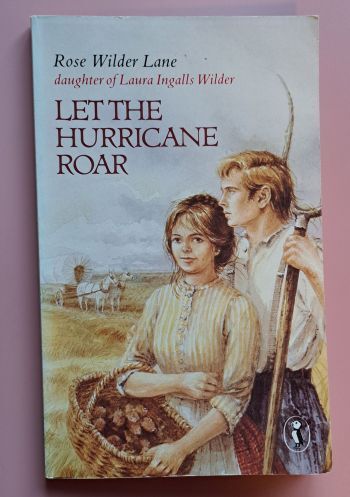 A thoughtful Christmas gift from my sister who knows how much I love and admire Laura Ingalls Wilderwhat I’ve been given as gifts
A thoughtful Christmas gift from my sister who knows how much I love and admire Laura Ingalls Wilderwhat I’ve been given as gifts(sometimes the giver will have chosen something that closely match my interests, other times it’ll be a book they’ve enjoyed)what treasures I’ve spotted in secondhand bookshops or Little Free Libraries
(I often choose books that are out of print and obscure)snippets of “Book of the Week” broadcasts I might have heard by chance on the radio
(I seldom hear the whole series)what else I’ve been reading recently
(I often play book tag, following associations across different genres)
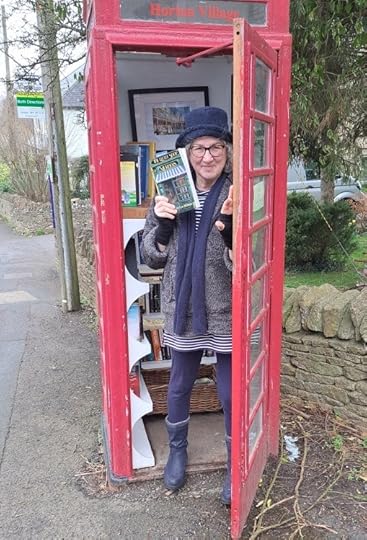
A little more explanation of “book tag” may be needed. For example, after reading Sathnam Sanghera’s history book, Empireland: How Imperialism Has Shaped Modern Britain…
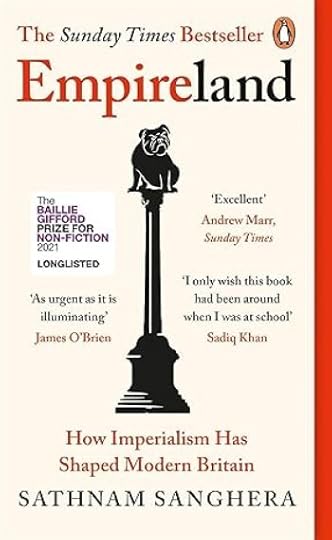
I started on Vaseem Khan’s cosy mystery set in modern India, The Unexpected Inheritance of Inspector Chopra…
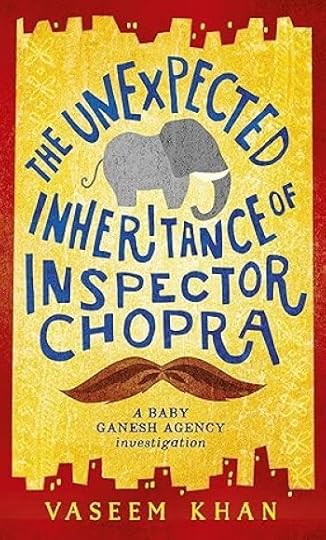
before travelling back in time to his historical novel set just after Indian independence and Partition, Midnight at Malabar House.
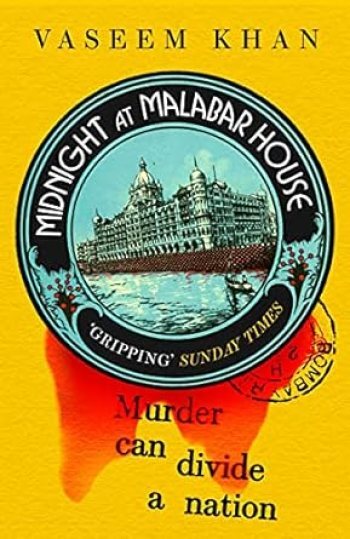
Although both Vaseem Khan’s books are first in series, and I plan to read the rest of the both series as I really enjoyed them, instead my next pick was Salman Rushdie’s Midnight’s Children, about a man born on the stroke of midnight of the day India gains independence.
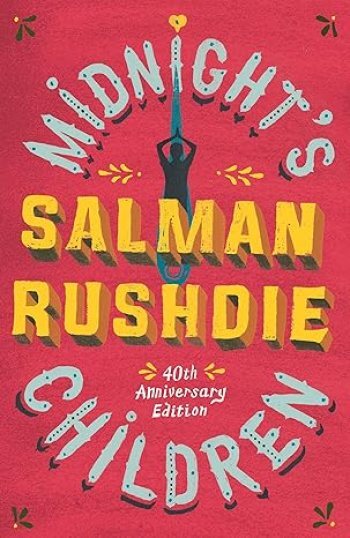
I’m now thinking I might move on to another book that takes Midnight as its theme. Yes, I have already read Philippa Pearce’s Tom’s Midnight Garden, thank you! But I welcome any more suggestions!
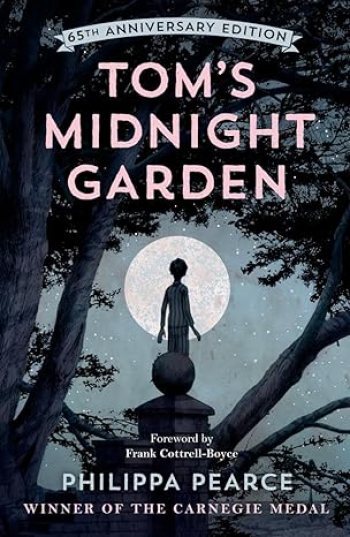
It’s only now I realise that at least three of these books have won major prizes – but lists of prizewinners are never a starting point for me when I’m choosing what to read next.
How will you decide which books you’ll read in 2024? I’d love to know!
IN OTHER NEWSA few years ago, I was surprised to discover that there are a lot of readers out there who love to read box sets of ebooks, and who will buy box sets almost exclusively. When I say “box set”, there’s no physical box involved – ebook box sets are really just a collection of books sold as a single product. (Personally, I have a great fondness for physical box sets of print books, as I wrote about here, when I was self-publishing my first box set of ebooks years ago.)
I’m pleased to announce that Boldwood Books, who now publish all of my novels, have just launched not one but three new box sets of my books – two in the Sophie Sayers series and one for Gemma Lamb. These are all now available to buy on all the usual digital platforms. Just put my name and the series title into the search box of your favourite ebook store to order your copy now.

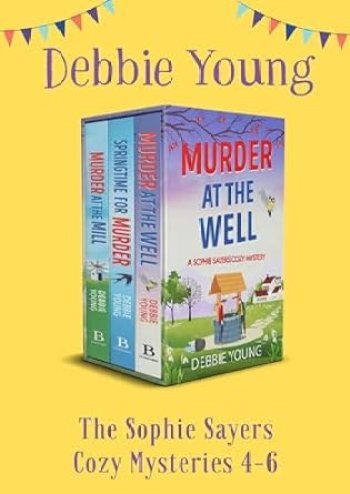
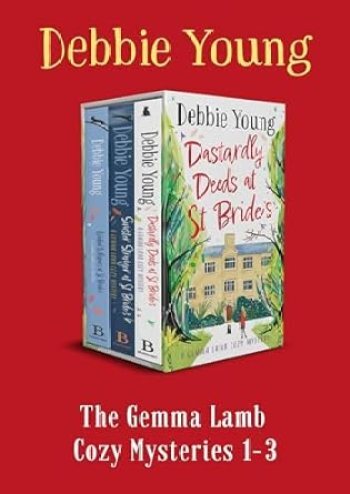
Next Wednesday I’ll be sharing a sneak preview of my next book, Driven to Murder, the ninth Sophie Sayers Cozy Mystery, which will be launched by Boldwood Books on Friday 26th January 2024. If you’d like Boldwood Books to email you about my new books, special offers and related competitions, you can sign up for their free mailng list here:
In the meantime, happy reading!
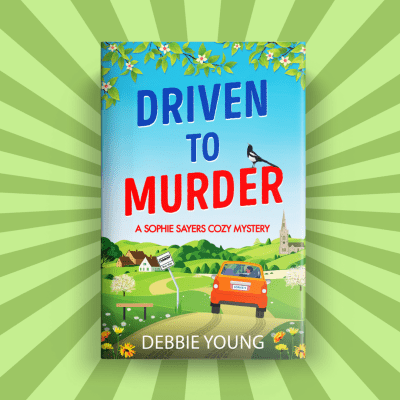 Coming soon!
Coming soon!
January 3, 2024
Busy Doing Nothing
“I really don’t have time to take a holiday.”
If you hear yourself saying that in the new year, it’s a sure sign that you need a break. There’s only one solution: take time out.
I speak from experience as an activity addict. My husband complains that if I spot a blank page on my diary, my instinctive reaction is to fill it, when it would do me far more good to take a day off.
Not only do I cram my days with activity, but I do everything intensively and fast. Only recently on a writing retreat did I realise my default setting is breakneck speed. Volunteering to do the group’s grocery shopping, an author friend and I set off round the local supermarket, me pushing the trolley at my usual purposeful quick march.
“Relax, you’re on holiday!” Alison gently laid a hand on my elbow to slow me to her preferred leisurely stroll. It hadn’t occurred to me there was any other way to shop – or indeed to do anything else.
But even the Duracell bunny must run out of charge eventually, even if the other bunnies aren’t there to see it keel over.
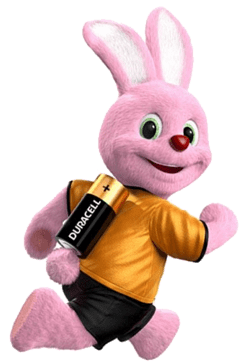 (Image by Duracell licensed for fair use https://en.wikipedia.org/w/index.php?curid=48645665)
(Image by Duracell licensed for fair use https://en.wikipedia.org/w/index.php?curid=48645665)So in 2024, I’ll be scheduling a weekly slot in my diary to do absolutely nothing. I’ll need to work at it, because it takes 21 days to form a new habit. But on a recent dummy run when, unwell, I managed a whole day of inactivity, I made an important discovery…
Doing nothing: it’s really something.
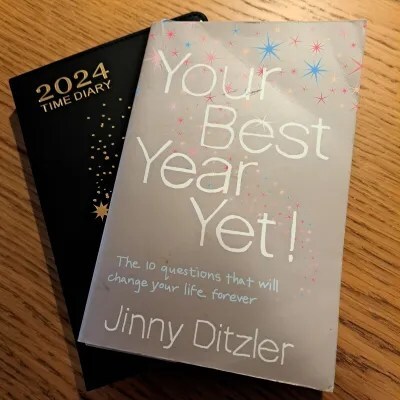 This little book has been helping me plan better use of my time for the last few years – that’s why it’s a bit dog-eared! It’s not too late to consult it out to help you make your own New Year plans – click the image to order it online. Huge thanks to author Lucienne Boyce for introducing me to this invaluable book back in 2019. i
This little book has been helping me plan better use of my time for the last few years – that’s why it’s a bit dog-eared! It’s not too late to consult it out to help you make your own New Year plans – click the image to order it online. Huge thanks to author Lucienne Boyce for introducing me to this invaluable book back in 2019. i(This post first appeared in the January 2024 edition of the Hawkesbury Parish News.)
In Other News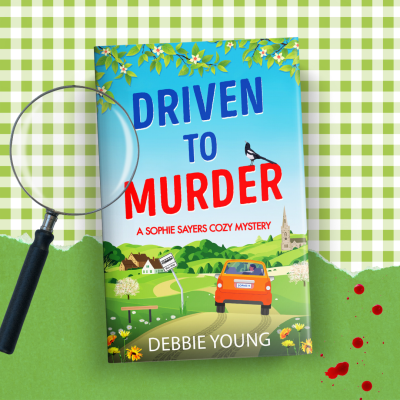 Out on 26th January – click the image to preorder online
Out on 26th January – click the image to preorder onlineThis month sees the launch of the ninth Sophie Sayers cozy mystery novel, Driven to Murder, in which to some extent art imitates life…
This story revolves around the cancellation of the local bus service – something that is happening in real life in my home village of Hawkesbury Upton, to the detriment of anyone who doesn’t have access to their own car.
But there the similarity ends – no murders on our real-life village bus to date!
I just wish I could engineer a happy ending for my village, in the same way that I always do in my novels…
Driven to Murder is available to pre-order now, for the official launch date of Friday 26th January.
Order your copy online here, or ask your local bookshop or library to order it in for you.
PS I love the way the designer’s referenced the book’s place in the Sophie Sayers mystery series on Sophie’s personalised licence plate!
December 26, 2023
Mistaken Identity
My last blog post for 2023 is the column I wrote for the December 2023/January 2024 double issue of the Tetbury Advertiser, written in the run-up to Christmas.
On my first trip abroad for over a year – only my second since before Covid – I find it refreshing to hear other languages spoken. My short break in the historic city of Bruges exposes me to far more than Belgium’s three official languages, French, Dutch, and German. The cheerful hotel receptionist who greets us in fluent English converses just as easily in Spanish with other guests. As we roam the cobbled streets, we catch drifts of Asian languages from tour guides leading walking groups.
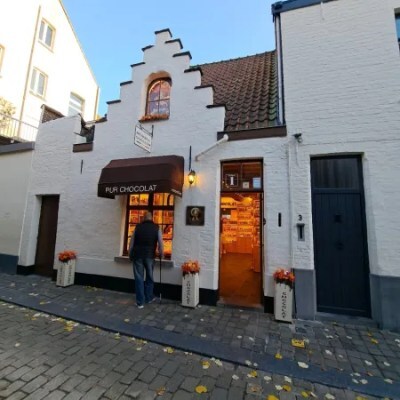 All the cobbled streets of Bruges inevitably lead to chocolate shops
All the cobbled streets of Bruges inevitably lead to chocolate shopsAmid this Babel, locals may find it amusing to guess the nationality of tourists and address them in the appropriate tongue. Before I open my mouth in shops and cafes, they speak to me in English.
I’m therefore surprised when, stopping on our way home at a Calais hypermarket, a checkout assistant asks me in rapid colloquial French whether I have a store loyalty card. She must think I’m on my home turf. I interpret this as a compliment. After all, aren’t French women always more elegant than British? On the other hand, she might just be going by the sparse contents of my trolley: it’s not full of the cheap wine and beer beloved by the typical British booze-cruiser.
Next day, back in England, I meet two old schoolfriends in Winchester. (I cover a lot of miles this week.) We’ve been best friends since our first day of secondary school. Although we now live too far apart to see each other very often, as soon as we’re together, we revert to our teenage years, dredging up old in-jokes and catchphrases, laughing and egging each other on.
We have chosen Winchester as a quieter alternative to our usual London rendezvous, but as I navigate through town to find a car park, I’m puzzled by the bumper-to-bumper traffic. When I spot a young man in an academic gown and mortar board posing for a photo beside the statue of Alfred the Great, I realise it’s Degree Day.
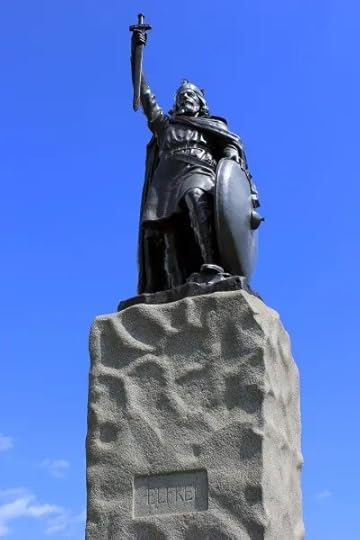 Winchester’s statue of Alfred the Great (Photo in public domain via Needpix)
Winchester’s statue of Alfred the Great (Photo in public domain via Needpix)Hundreds of new graduates are flocking with their proud parents to ceremonies in the cathedral. What’s more, surrounding the cathedral is the newly-opened Christmas market, housed in dozens of little huts reminiscent of a medieval village. As we browse the market stalls, my friends and I are often separated by the crowds. I’m repeatedly casting around to find my companions.
When a mature lady with grey hair and glasses makes eye contact with me from a few yards away, I wonder why she’s looking at me so pointedly. Then to my astonishment words come out of her mouth in the distinctive voice of one of my old schoolfriends, and I do a double-take. For a moment I’ve forgotten how much we have aged. But then she laughs at me, and I don’t care. On the outside, we may be grey-haired and bespectacled, but for today at least, on the inside, we’re still in our teens.
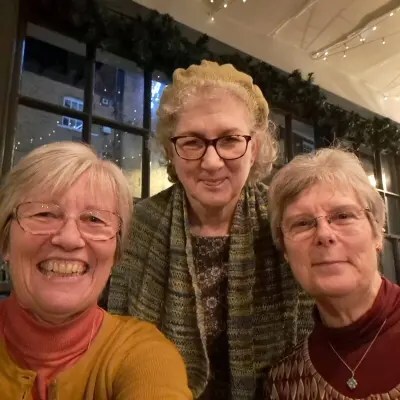
Whatever age you are now, I wish you the brightest and best of Christmases, and a peaceful, healthy and fun-filled New Year.
I’ll be back in January, with a weekly blog post, including articles about writing craft and reading habits, and a monthly post about a fellow author, as well as continuing to share articles I’ve written for magazines and other blogs. See you next year!
NEW FOR JANUARY 2024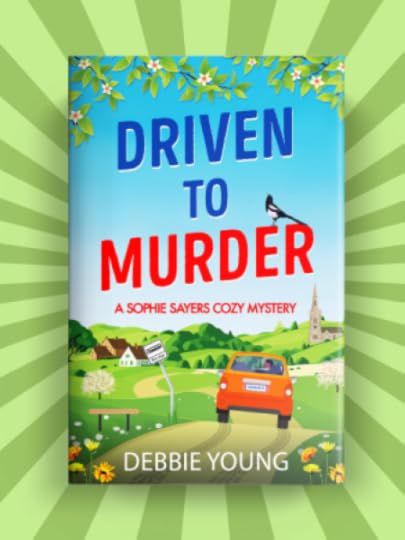 Coming 26th January 2024!
Coming 26th January 2024!Sophie Sayers’ ninth adventure, Driven to Murder, will be launched on Friday 26th January in paperback, ebook, audiobook and hardback. Pre-order now via your favourite store for a treat to brighten the dark days of January!
Change is coming to Wendlebury Barrow – and not everyone is happy about it…
When the local bus company announces it will be stopping its route through their quaint Cotswold village, the people of Wendlebury Barrow are up in arms. Not least Sophie Sayers, whose driving lessons with her boyfriend Hector get off to a bumpy start.
But the locals’ peaceful protests against the decision turn deadly when a body is discovered on the Number 27. No one can work out how a passenger met their demise, let alone how the driver didn’t notice. While the police wait for the post mortem results, Sophie immediately suspects foul play, and launches her own investigation.
Can she solve the murder before another passenger is hurt – and save the village bus service? As ever, she’ll give it her best shot!
December 6, 2023
The Sound of Christmas
‘It’s beginning to sound a lot like Christmas,’ as Bing Crosby didn’t sing in one of the most iconic secular songs of the festive season.
These days, the two things that excite me most about Christmas are seeing all the fairy lights appearing in the darkness and hearing Christmas music. I’m always relatively late putting up Christmas decorations in my house, rushing to get our tree into the front window minutes before the lights are turned on at The Plain (our village green). But I’m always early with the festive music.
Not for me the modern stuff. I do understand the appeal of such classics as Slade’s “Merry Christmas Everybody”, and I have a soft spot for pop’s best two festive duets – Bing Crosby and David Bowie singing “Peace on Earth/The Little Drummer Boy” and The Pogues’ and Kirsty McColl’s “Fairytale of New York”.
But I prefer traditional Christmas music. I’m bashing out carols on the piano and dusting off the Handel’s “Messiah” CDs as soon as Remembrance Day is over. I love it all, from ushering in Advent with “Hills of the North, Rejoice” (rumoured to our vicar’s favourite), to finally being allowed to sing the “Christmas Day only” verse of “O Come, All Ye Faithful”.
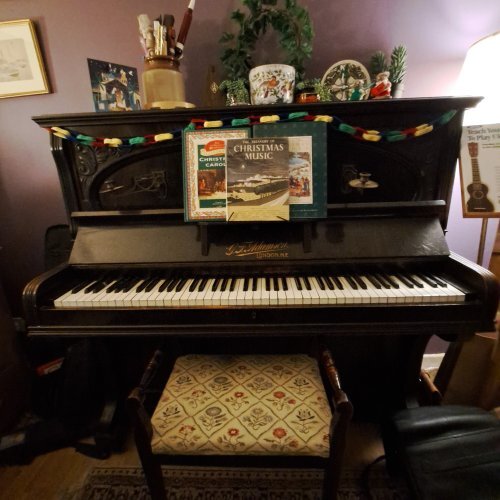 (Do you like my knitted ‘paper’ chains?)
(Do you like my knitted ‘paper’ chains?)Some of my earliest childhood memories of Christmas involve carol singing.
I vividly recollect at the age of about six being made to sit on the edge of the school hall stage beside a boy called Patrick to sing “In the Bleak Midwinter” together in front of the whole school. I have no idea why we weren’t allowed to stand. Maybe our teacher thought if we threw ourselves into our singing, we might fall off the stage.
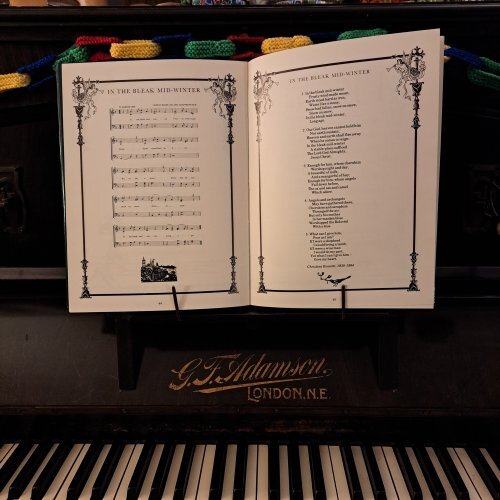 My favourite carol, ready to be played on my grandma’s antique piano
My favourite carol, ready to be played on my grandma’s antique pianoChristmas carols still feature heavily in my festive schedule, whether singing in the church choir, on The Plain, or in the car to brighten a journey on a dark winter’s night. “In the Bleak Midwinter” is still my favourite.
Little wonder then that when I was writing my latest book, Christmas with Sophie Sayers, carols kept popping into my head and onto the page.
But the final tale in this new collection of festive short stories is inspired by a different kind of music that I’ve come to appreciate more recently: church bells. I confess I hadn’t even thought of them as being a musical instrument until the new bells were installed at St Mary’s and I took up ringing. Before then, I’d just thought of them as the source of a loud noise serving a public information purpose, like a tuneful version of the foghorn. (Don’t tell the Tower Captain!)
The many sounds of Christmas will resonate around the village as the year draws to a close. Whatever soundtrack you prefer for your festive celebrations, I wish you the happiest of Christmases and the best of New Years.
Recommended Short Stories for ChristmasWhen life in the run-up to Christmas can seem so busy and stressful, it can be hard to find time to get stuck into full-length novels. Short stories which may be read and digested at a sitting are the perfect alternative – and I have two collections of stories that will help you destress and fill you with Christmas spirit.
CHRISTMAS WITH SOPHIE SAYERSChristmas with Sophie Sayers is part of the Tales from Wendlebury Barrow series – gentle, funny tales of village life, set in the same world as my Sophie Sayers Cozy Mysteries, but with not a murder in sight! It’s available in paperback and ebook and makes a great stocking filler or gift-to-self.
Available to order online here from a multitude of stores.
Signed copies of the paperback available on request (UK only) for £6 plus cost of postage – just send me a message via the contact form to place an order.
 Noe available in ebook and paperback – the perfect stocking filler!What Readers Say about Christmas with Sophie Sayers
Noe available in ebook and paperback – the perfect stocking filler!What Readers Say about Christmas with Sophie Sayers“These are feelgood short stories, where even being snowed in for Christmas seems to be a jolly jape” – book reviewer London Lass
“Ideal for a Christmas stocking filler – these delightful short stories about Sophie Sayers and her boyfriend, bookshop keeper Hector, can’t fail to please!” – Helen Hollick
“A trip to Wendlebury Barrow is always a treat, and at Christmas when the village tree is decorated, the carol singers out in force, and the nativity play in full rehearsal it’s especially appealing. A lovely collection of gentle, charming stories with a festive theme.” – Lucienne Boyce
“This new collection of short stories is sprinkled with gentle festive warmth, banter and humour, and with not a murder in sight. Oh — and you will come away an expert in the art of bell-ringing! A lovely stocking filler. Merry Christmas!” – Karen Inglis
STOCKING FILLERSUnrelated to any of my novels, and published back in 2014, Stocking Fillers, my collection of 12 short stories on different aspects of Christmas, still sells well at Christmas, particularly in paperback. I guess readers are taking the title as a hint to buy it as a stocking filler present for friends and relations. Both books also make great Secret Santa gifts. Being slim books, they’re priced at just £5.99 for the paperback, so very affordable, whether for others or as a treat-to-self to get you into festive mood!
Available to order online here from a multitude of stores.
Signed copies of the paperback available on request (UK only) for £6 plus cost of postage – just send me a message via the contact form to place an order.
What Readers Sayabout Stocking Fillers
“A delightful celebration of all things Christmas, Stocking Fillers features 12 funny, thoughtful, surprising and heartwarming tales that will get you in the festive spirit. Debbie Young’s writing is thoroughly engaging. If you’re looking to put some of the magic back into Christmas, and rediscover the reason for the season, start by treating yourself to this lovely read.” – Rebecca Lang
“From the opener, The Christmas Letter with its quirky take on male self-absorption, through the too clever by half boy in Do You Believe, each tale delights with unexpected twists and turns. More importantly, Debbi Young writes with such a keen eye on the vagaries of human nature, both good and bad, but never just ordinary. If you get a chance to pick this up for Christmas you’re in for a treat. But remember, a book isn’t just for Christmas, and this one will make you smile all year long.” – David Penny
“I thoroughly enjoyed this collection of 12 (very) short stories – one for each of the twelve days of Christmas. Well written; each story as thoroughly enjoyable as the next. Some witty, some intriguing, all excellent. I’ll definitely pick this up to read again next Christmas.” – book reviewer Dee, via Amazon
“I’m not normally a short stories reader but I adored this little book. So well written, such an interesting mix, and perfect bedtime reading. Put me right in the mood for Christmas. Loved it.” – JD Kabler
November 8, 2023
So, You Think You’ve Got a Book in You?
13 years ago, I gave up my full-time day job to focus on my writing. Now I earn my living from writing and writing-related activities such as public speaking and teaching. This post is to encourage anyone who has often thought they’d like to write a book that it’s never too late to start – and how to go about it.
Do you often think, “I could write a book, if only I had the time”? The long, cold dark nights of November make spending leisure time outdoors or away from home less appealing. So why not take the opportunity to start getting that book out of your head and down on paper?
Whether you plan to share your story with the world or want to write for your eyes only, here are some handy tips to get you started.
 I’m extremely lucky to have my own writing hut at the bottom of my garden – my husband’s lockdown project…
I’m extremely lucky to have my own writing hut at the bottom of my garden – my husband’s lockdown project…• Choose a space that will be your writing station. It doesn’t have to be a separate room. Jane Austen wrote her novels on a foldaway table in the corner of her living room.
• Block out time in your diary to write every day – it’ll soon become an ingrained habit.
• Commit to writing just 10 minutes every day. Make a star chart and give yourself a star every day you achieve your goal. You’ll often find you’re writing for much longer, because within that short time you’ll get into your stride and not want to stop.
• Always keep a notebook to hand for jotting down ideas. Put it on your bedside table to ensure you remember those middle-of-the-night “Aha!” moments in the morning.
• Don’t try to write perfect prose (or indeed poetry) – just scribble or type away. A scruffy first draft is better than an empty page. You can fine-tune your words later.
• Write the sort of thing you’d like to read and be your authentic self. Every writer is unique, so don’t try to be someone else, unless writing fan-fiction –a great way to practise your writing skills.
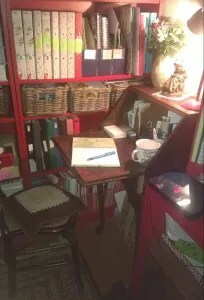 My fiction writing desk
My fiction writing desk• Write from the heart and write what you know. What are you passionate/knowledgeable/evangelical about? Everyone’s an expert or advocate in some way.
• Don’t judge yourself. Every published author has imposter syndrome at some point, so you’re in good company.
• Don’t let your age put you off. Mary Wesley didn’t publish her first novel until she was 70, and her books have become modern classics. The best time to start is now.
• Put some fancy stationery on your Christmas wish-list to encourage you to keep writing in the new year…
 My early Christmas-present-to-self – a Victorian brass pen tray and vintage Parker pen, bought at a local vintage flea market at prices too good to resist!
My early Christmas-present-to-self – a Victorian brass pen tray and vintage Parker pen, bought at a local vintage flea market at prices too good to resist!You don’t have to pen a bestseller to enjoy writing. You don’t even have to share your work with anyone else if you don’t want to.
But thanks to the internet, it’s never been easier to put your work in front of an audience, whether in book form or on your own website or blog. Analogue is fine too. After all, you don’t have to look far to find a friendly parish magazine* that publishes local writers’ work in print…
Good luck, and happy writing!
*This post was first published in the November 2023 issue of the Hawkesbury Parish News , for which I’ve been writing a monthly column ever since I quit the day job, as mentioned above. During the same timeframe, I’ve been writing my monthly “Young By Name” column for the Tetbury Advertiser .
These columns are now collected into books every few years, and four volumes are now available in ebook for Kindle (read for free in Kindle Unlimited) and to order in paperback from Amazon and all good bookshops.
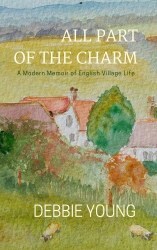
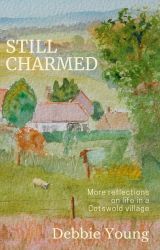
The Charmed series includes my columns for the Hawkesbury Parish News.
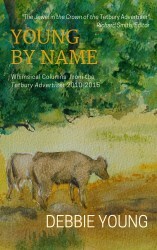
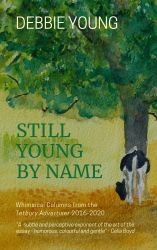
The Young By Name series contains my Tetbury Advertiser columns.
November 4, 2023
On Your Doorstep
People who live in large, sparsely populated countries have a different definition of ‘nearby’ from ours. I know someone who thinks nothing of driving two hours for their weekly shop, including a stint on a car ferry. Another friend drives twelve hours to their ‘local’ hospital. When we asked my visiting Canadian cousin where she’d like us to take her while she was in England, she said ‘France’. My aunt, her grandmother, chose Scotland.
How lucky we are here in the Cotswolds to have so much within easy reach – not only essential facilities, but places of historic and cultural interest to enrich our lives. My latest discovery on our doorstep is the tiny, historic church of St Andrew at Leighterton. (Other tiny, historic churches are available, as the BBC might say.)
Like so many of Gloucestershire’s hidden gems, St Andrew’s is not far from a main road, but unless you have cause to drive down a very minor and winding lane, you’d never know it was there.
When I finally see St Andrew’s for the first time, I am wrong-footed by its boxy shape and quaint half-timbered tower. The architecture puts me in mind of stories by Hans Christian Anderson or the Brothers Grimm. When I share a photo online, a friend says it looks Norwegian.

I halt my car to give way to a parade of ducks waddling down the middle of the road beside a pond. Then a white goose comes towards me, like some kind of feathered escort for the slow-moving car behind it. I half-expect the goose to wield a red flag, as used in the early days of motoring.
Have I now driven into an Enid Blyton illustration, or is this just a typical Lightroom rush-hour? Either way, I’m charmed.
The church door is locked, and I must wait until the following week to be taken inside by a keyholder. The interior doesn’t disappoint.
Above deep sills, stained glass windows splash colour against the pale cream walls.

Dark ceiling timbers are echoed at ground level by row upon row of wooden pews.

The compact chancel, featuring a beautiful mural in the style of Frederic Leighton, shelters behind a low stone arch. To one side of the arch, a chunky stone pulpit makes a good companion piece to the sturdy 14th century font by the porch door.

To the other side, an organ has been made-to-measure to fill a second arch.

I discover a musical surprise behind a red velvet curtain: a ring of tubular bells.

After taking over 30 years to discover St Andrew’s, I’m returning rather sooner: on Thursday 9th November at 7pm, to sing with Hawkesbury Choir in a candlelit Concert for Reflection and Hope, directed by Ben Humphries with Ben Haslam on the trumpet and January Johnnsen on the viola, in aid of Help for Heroes, Macmillan Cancer Nurses, and St Andrew’s Church. For more information and to book tickets (£10 including wine), visit www.badmintonbenefice.com.
Just try not to be disappointed if The Snow Queen, Little Red Riding Hood and Noddy aren’t in the audience.
This post was written for the November 2023 issue of the Tetbury Advertiser, and St Andrew’s, Leighterton is in its catchment area.
IN OTHER NEWSWith my writer head on, I’m currently preparing for two book talks, and if you’re anyway near my home village of Hawkesbury Upton or the nearby Cotswold market town of Stroud, I hope you’ll want to come and join me! Click the images fore more information and to book tickets.
At the Stroud Book Festival Cosy But Criminal event, Kat Ailes and I will be talking about the defining characteristics of so-called cosy crime fiction, what has inspired and informed our contributions to the genre, and why it’s so enduringly popular. We spent two hours chatting recently about how we’re going to fill our hour, so I am sure we will have plenty to say!
At the last HULF Talk of 2023, part of the Hawkesbury Upton Literature Festival series of events that takes place in my home village in the Cotswolds, I’ll be joined by 12 local authors sharing all kinds of books – all of which would make great Christmas presents for your friends and relations, especially when personally signed for them at our event! It’ll also be the official launch of my hot-off-the-press collection of festive short stories, Christmas with Sophie Sayers. Do come and join our celebrations! You’ll find more info on the website at www.hulitfest.com, and also the booking link for tickets. Or just click the image above to hop right to it.
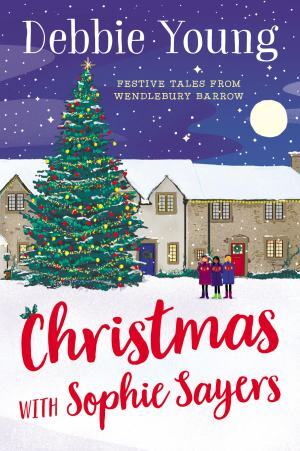 Launching at the HULF Christmas Special – come and help me celebrate!
Launching at the HULF Christmas Special – come and help me celebrate!
November 1, 2023
What’s in a Name?
Have you ever wanted to visit a place simply because its name intrigued you?
On a short break in North Devon, I am pleased to have the opportunity to visit Westward Ho! The exclamation mark that is part of the seaside town’s official name makes it sound so thrilling. The only thing I know about Westward Ho! is that Charles Kingsley wrote a novel by that name, so I assume he thought it worth celebrating.
Yet as I plan our trip, I discover the novel Westward Ho! predates the town. Kingsley wrote it in 1855 while living in Bideford. (See header photo for Bideford’s statue in his honour.) Only in 1863 did an enterprising firm of developers start building an eponymous town nearby to cash in on the novel’s popularity.
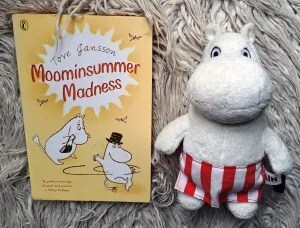 We love the Moomins…
We love the Moomins…In most countries, there’s no copyright on book titles, so I wonder this doesn’t happen more often. It’s a much more exciting approach to merchandising than the usual t-shirts, tea-towels and tote bags. My daughter and I would visit a real-life Moomin Valley like a shot.
So, if Kingsley’s book didn’t take its name from the town, where did it originate?
Received wisdom is that it came from Victorian water-taxi signs indicating their direction of travel along the Thames. There was also a play by the same name, written by John Webster and Thomas Dekker in 1604, about the westward expansion of London. There followed plays called Eastward Ho! and Northward Ho! but no Southward Ho! Maybe Jacobean playwrights, like London cabbies, didn’t like going south of the river.
I wonder whether Westward Ho! is the only place name in the world to include an exclamation mark, and I’m pleased to discover another town with not one but two.
I think St-Louis-du-Ha!-Ha! in Quebec, Canada, sounds like a fun place until I find it’s named after the French word haha, meaning an impasse, rather than for a civic sense of humour. It’s the same word we use in English to mean a concealed trench to prevent animals passing from farmland to gardens, dispensing with the need for a fence or wall that might spoil the landowner’s view.
The nearest haha I know to Tetbury is at Westonbirt School, at the edge of its Grade I listed gardens. (See Historic England’s offical mention of Westonbirt’s haha here.) A vintage list of school rules forbids pupils from roaming beyond the haha. This instruction must have perplexed new girls, unless they all had hahas at home.
Meanwhile, back in Bideford, I discover on YouTube a satirical song called “Westward Ho! – Massive Letdown” by Half Man Half Biscuit.
With a discography that includes “Trouble Over Bridgwater”, “Back in the DHSS”, “Dickie Davies Eyes”, and “Voyage to the Bottom of the Road”, there’s a band that knows how to work a name.
Consequently, when I finally arrive at Westward Ho!, I’m bracing myself for a let-down, but thick fog drifts in from the sea shrouding the whole place, making it impossible to form a fair judgment. My sense of wonder therefore remains intact. Not so my computer’s grammar checker, sent into meltdown by all those rule-breaking exclamation marks.
(This post first appeared in the October 2023 edition of the Tetbury Advertiser).
IN OTHER NEWS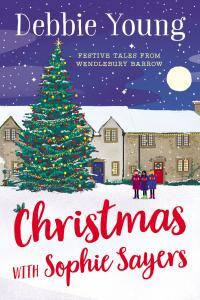 Launching Friday 24th November
Launching Friday 24th NovemberThe manuscript of my next novel, Driven to Murder, (Sophie Sayers #9) with the proofreader, and due to be published on 26th January 2024 (ebook available to pre-order here with a placeholder title – cover reveal to follow soon).
I now have a little leeway to work on another project that I’ve been planning for literally years – a new collection of festive short stories featuring Sophie Sayers and her friends from my Sophie Sayers Village Mysteries.
One of the stories also features staff and pupils at St Bride’s School, when Gemma Lamb accompanies a party of school carol singers to Wendlebury Barrow.
The collection also includes my first (and so far only) story about Sophie’s late Great Auntie May, in Christmas Ginger.
Some of the stories have been shared online before, and Christmas Ginger was included in the Everyday Kindness anthology, edited by L J Ross to raise funds for housing charity Shelter. But this is the first time the stories have been brought together in a book.
This collection of gentle, feel-good stories of Cotswold village life (with not a murder in sight!) would make a great stocking filler or Secret Santa present, or indeed a gift-to-self to help you get in festive mood.
Christmas with Sophie Sayers will be published worldwide on all the major retail platforms un paperback and ebook on Friday 24th November. The ebook is already available to pre-order on Amazon here. I’ll share buying links for other digital channels including Apple, Kobo and Nook as soon as they’ve been confirmed.

